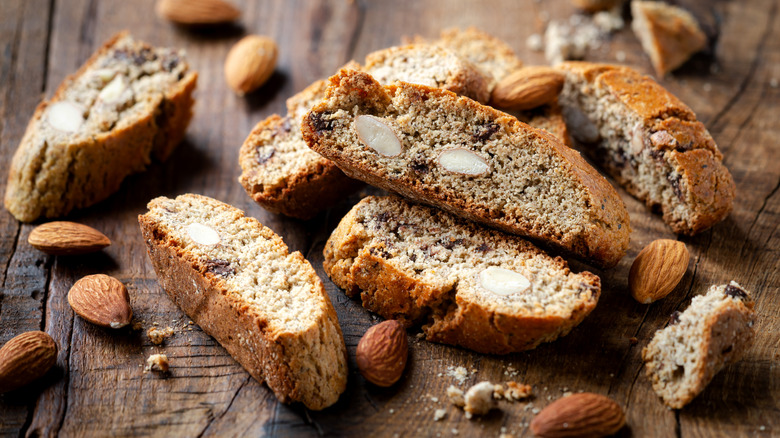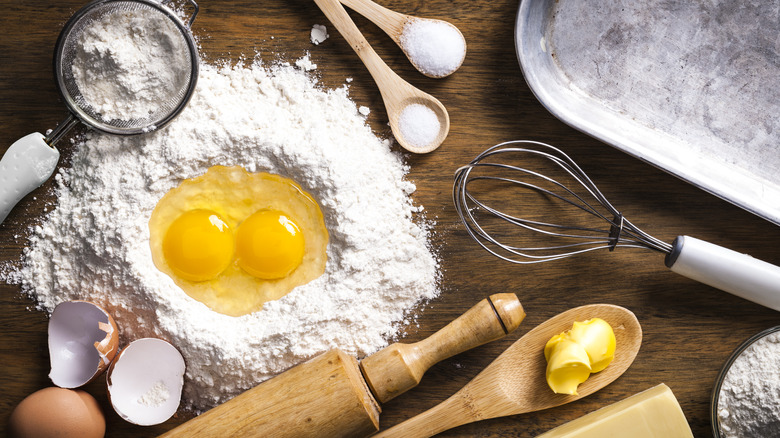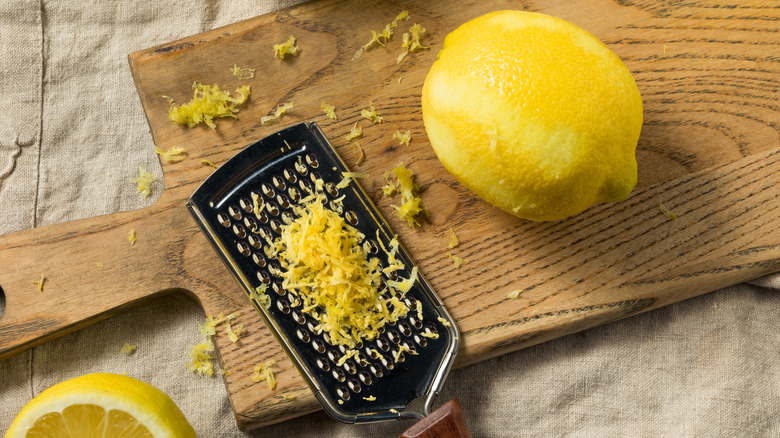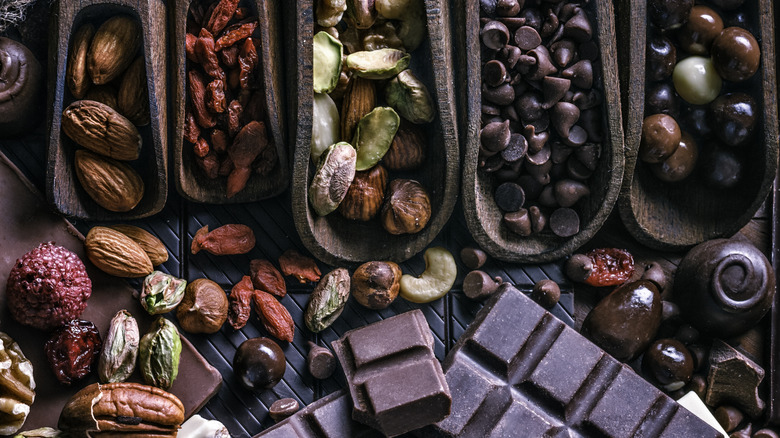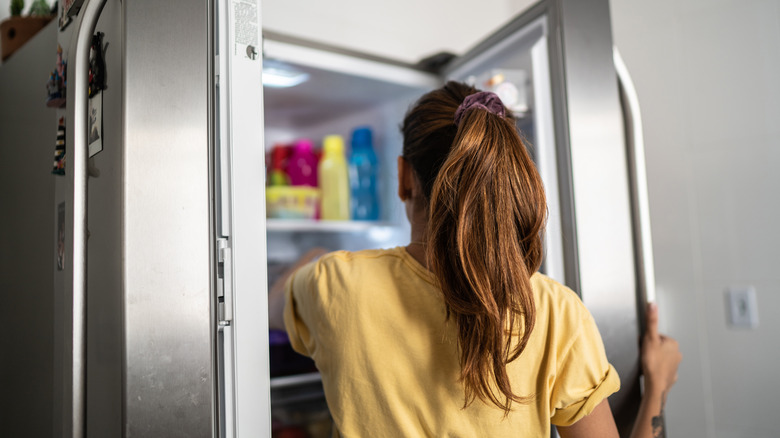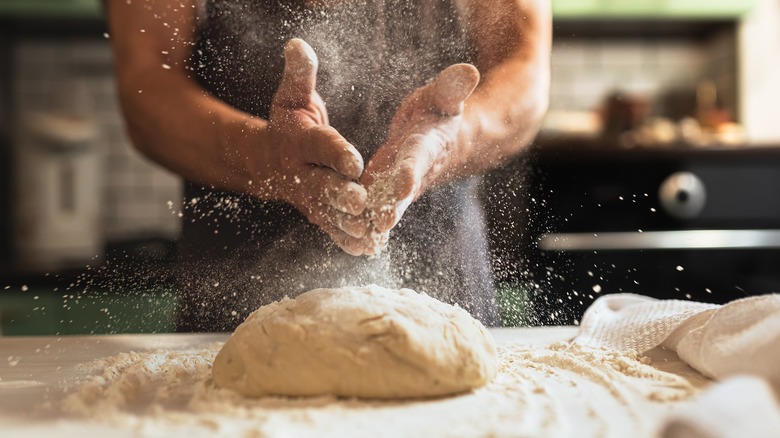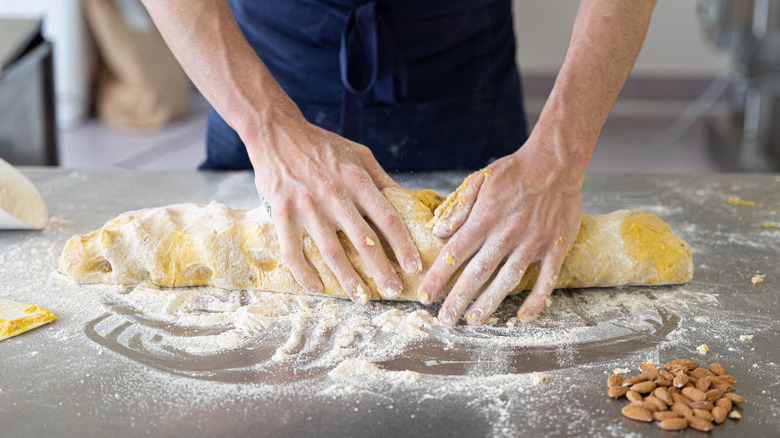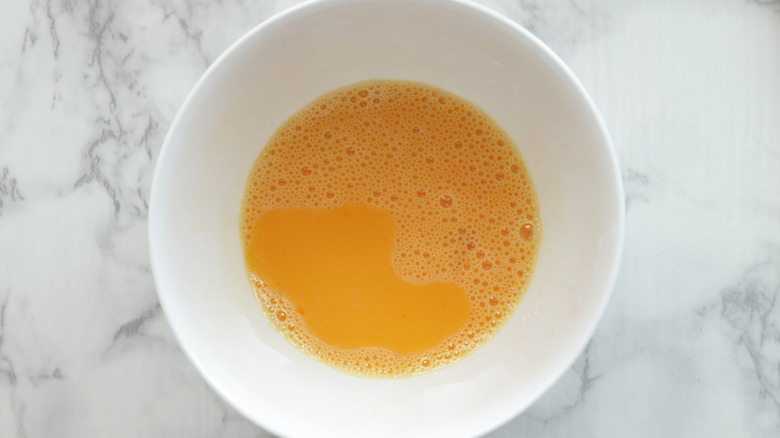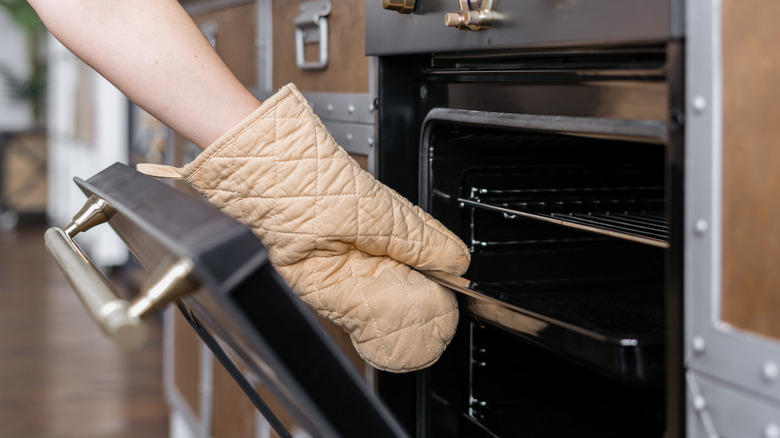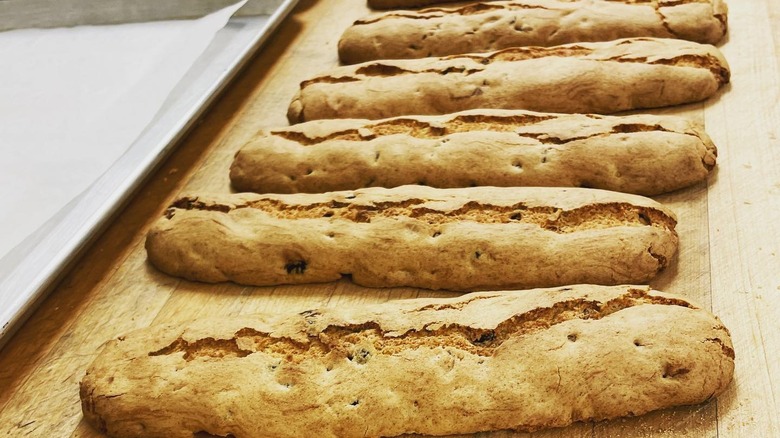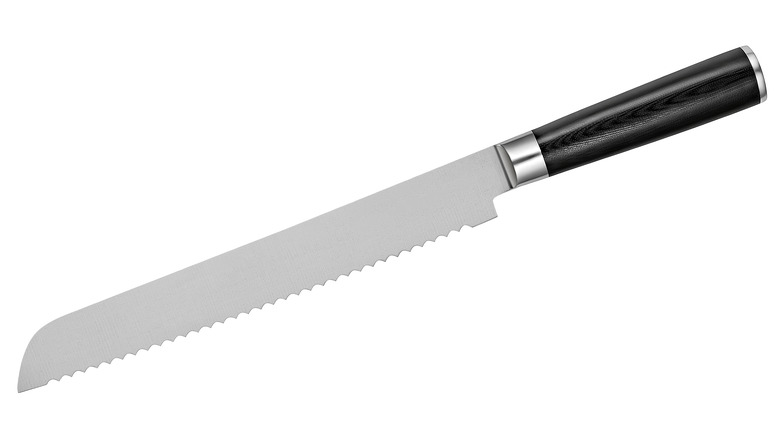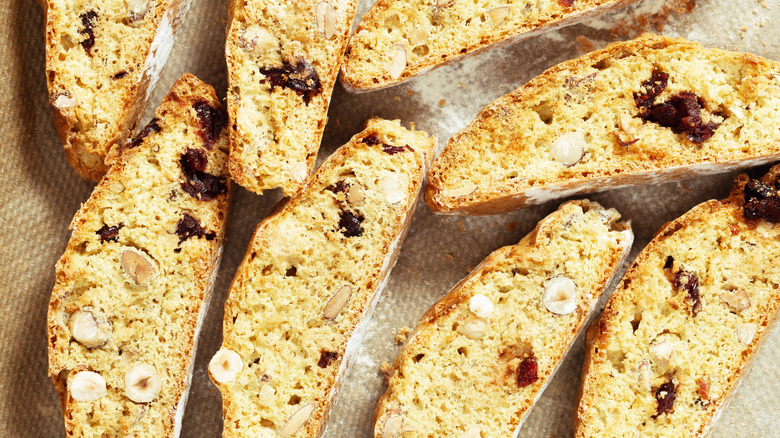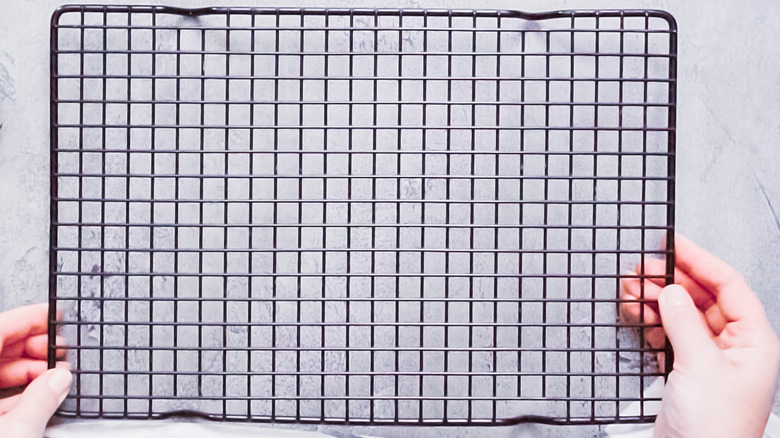12 Tips For Making The Absolute Best Biscotti
With origins in Italy, biscotti reigns alongside cherished Italian desserts like panna cotta, tiramisu, and zabaglione. However, biscotti stands apart like a bright star when it comes to simplicity and versatility. This popular Italian cookie is made with basic pantry staples (eggs, butter, sugar, flour) and can be flavored with extracts, dried fruits, candies, and citrus zest, making it great for holiday gifts, cookie trays, or an anytime snack.
Bakers make this uniquely brittle cookie by double-baking the dough. The first bake forms the crust and cooks the interior, while the second bake dries the crumb completely. The result is an outrageously crisp cookie with a remarkably long shelf-life and dry texture perfect for dunking. While baking a tray of dry and brittle cookies isn't typically a baker's goal, biscotti is an exception because the rugged texture is what makes this treat so special.
If you've never had success making homemade biscotti, now is the time to try again. Of course, making biscotti from scratch is more involved and time-consuming than scoop-and-bake cookies (hello, chocolate chip), so plan accordingly. To get you started, we're sharing our best advice on making a stellar batch. So grab your apron and check out the tips below to bust out biscotti that's sure to impress.
1. Use room-temperature ingredients
If you've tried making biscotti before and the dough didn't come together, it may be because the wet ingredients were too cold. When baking, the temperature of the ingredients makes a big difference. Like many cookies, biscotti is made with the creaming method — butter, sugar, and eggs beaten together to form a smooth emulsion that traps air. When baked, that trapped air expands to produce a fluffy, uniform texture. However, if the ingredients are cold, the emulsion never forms, resulting in dense cookies.
To ensure your biscotti dough properly forms, remove the butter from the refrigerator at least one hour before using it. If you have a microwave, you can also nuke cold butter in 10-second bursts on low until malleable. Like butter, the eggs should be brought to room temperature (70 degrees Fahrenheit) before use. You can get eggs to room temperature relatively quickly by letting them sit in a bowl of warm (not scalding) water for a few minutes. When the eggs feel warm to the touch, you're clear to start cracking.
2. Boost the flavor with spices, extracts, and zest
There's nothing more disappointing than bland biscotti. Unless you add some flavoring to the dough, homemade biscotti will be pretty dull and not all that palatable. When you're working with a cookie like biscotti that's hard and dry, adding flavor is a must.
Thankfully, you likely have a slew of flavorings in your cupboard that can be used to turn boring biscotti into something more exciting. Aromatic spices like cinnamon and anise are perfect for adding warm notes. If it's around the holidays, try allspice, ginger, or nutmeg. And that vanilla extract you always use in cakes? You should use it in biscotti to enhance and balance flavors while lending sweet floral notes. There's always almond extract, a classic flavoring for biscotti, and orange extract, which adds a fresh, delightful pop, too. Lastly, consider using freshly grated citrus zest to add some zing, especially in biscotti with dried fruit bits.
Pro tip: If using citrus zest, rub it with the sugar called for in the recipe for one minute before mixing it into the dough to impart more flavor!
3. Toss in some add-ins for flavor and texture
Who doesn't love a good add-in? Especially when it adds bright flavor and interesting texture to a baked good. When it comes to biscotti add-ins, the possibilities are endless. If you ask us, nuts are among the most delicious and easiest add-ins. Almonds, walnuts, and pistachios all provide wonderful crunch and excellent flavor to biscotti.
Word to the wise if you add nuts to your biscotti: Stay away from whole nuts, as they will make slicing difficult. Instead, chop them finely before adding them to the dough — but don't forget to toast them first to intensify their flavor and improve their texture. Even better, grind a handful of the toasted nuts into a fine meal to fully integrate the nut's flavor into the biscotti dough.
On the flip side, you may think that biscotti sans nuts have a sufficient crunch on their own. If that's the case, try adding soft and chewy dried fruit to the dough to contrast the biscotti's crispiness. A bit of a health nut? Make a good-for-you batch of biscotti by substituting some of the flour for whole wheat flour and adding dried cranberries and walnuts. Have more of a sweet tooth? Mix in dark chocolate chips for an indulgent twist.
4. Let the dough chill before shaping
Biscotti dough is straightforward to make. It involves creaming butter, sugar, and eggs in a bowl, then mixing in flour, leavener, and flavorings until just incorporated — no kneading required. The whole process takes less than 5 minutes.
Sometimes though, when you grab the dough to begin shaping it, you're met with a tacky, sticky blob that can be hard to handle, possibly due to inaccurate measurements, the temperature of ingredients, or even the weather. Fortunately, there's an easy fix. Place the dough in a floured bowl and let it chill in the refrigerator for 30 minutes. You can even store the dough overnight if you decide you've had enough biscotti-making for one day (we won't tell). The dough will firm up in the refrigerator, making it easier to shape.
There's no benefit of rushing when you're making biscotti. Since the dough comes together in less than 5 minutes, sparing 30 minutes to chill the dough is an easy step for your biscotti to turn out better. Chilling the dough will prevent it from spreading too much in the oven while baking. It's a step worth taking because there's nothing sadder than a flattened loaf of biscotti.
5. Use floured or greased hands to shape the dough
Even after chilling, the biscotti dough can remain tacky, making it a challenge to shape. To limit any bumps along the way, start by dusting your work surface and hands with flour before handling the dough. Then, as you shape the dough into a log-shaped loaf, add more flour, a little at a time, until you achieve the desired shape and size. Finally, transfer the loaf to a lined baking sheet, and give the dough one final pat down with a lightly floured hand to smooth it out.
If this sounds like one big floury mess, you can leave the flour in the cupboard and instead shape the dough directly on a greased or parchment paper-lined baking sheet, saving you the hassle of transferring the dough from a floured work surface. Moisten your hands with a bit of water (instead of flour) to prevent them from sticking while shaping the dough. You can also grease your hands lightly with nonstick cooking spray instead of water.
6. Shape the dough into a smaller loaf than you want
Shaping biscotti dough is as easy as forming a meatloaf, but keep in mind that, unlike meatloaf, biscotti dough expands quite a bit as it bakes in the oven. The solution? Form the dough into a loaf smaller than your desired size and give it enough room to expand as it bakes.
If your recipe yields two biscotti loaves, don't put them too close together on the baking sheet, as this could lead to disastrous results. For perfectly shaped biscotti, you need to give the log-shaped loaves enough space to expand so they don't bake into each other. Otherwise, you'll be stuck using a knife to separate the conjoined loaves. Additionally, the extra room between the loaves will allow the hot air in the oven to flow around the loaves on all sides so they bake evenly.
Finally, remember that sometimes, no matter how hard you try, two loaves may not fit on one baking tray. Though this may frustrate the efficiency enthusiast in you, it's best to relent and bake the loaves one at a time. Remember, there's no need to rush when making biscotti.
7. Add a glossy shine with an egg wash
Before baking your biscotti loaf, take a few minutes to brush a light coating of egg wash onto the top. As the egg wash bakes, it will turn golden brown with a glossy shine. The egg wash will give the rounded edge of your cookies a lovely sheen, a more professional look, and a crispier bite.
To make egg wash, beat one egg and 1 tablespoon of water in a small bowl until combined. Then, mix in a pinch of salt to help break down the protein in the egg, thinning out the wash so it's easier to brush over the loaf. The added salt brings another benefit, adding a savory taste and cutting some of the sweetness in the biscotti. However, remember that a bit of salt can go a long way, so use it sparingly.
When making the egg wash, you can substitute whole milk for water for an even deeper color and glossy sheen to your biscotti. The result will be a golden crust with a reflective sheen. But if you desire even more shine, choose half-and-half or heavy cream since the richer the dairy, the brighter the shine. Just remember that richer dairy will brown the top of your baked goods faster, so you may need to tent the biscotti loaf with foil during baking.
8. Bake in the middle of the oven
For perfectly cooked biscotti, it's important to use the right oven rack when baking. We recommend baking biscotti on the middle rack for the best results. This is because the center zone of the oven, where the middle rack sits, provides the most even heat and allows hot air to flow around the biscotti. The middle rack is equidistant from the top and bottom heating elements, allowing even heat from all sides.
The top oven rack is suitable for broiling or crisping foods, as it sits closest to the top heating element. Similarly, the bottom oven rack's heating element is good for browning crusts (think pies). Because these two racks are so close to the heating elements, they also risk burning faster. The food on the lower rack may burn on the bottom, while the food on the upper rack may burn on the top. So your best bet is to stick to baking biscotti on the middle rack for moderate, even heat.
If you decide to bake multiple trays of biscotti simultaneously, rotate the trays onto different racks halfway through the bake for even cooking. This allows you to expose the cookies to the top and bottom heat intensities for an even amount of time.
9. Don't let the biscotti loaf sit too long after the first bake
After removing your biscotti loaf from the oven, you'll need to let it cool slightly before slicing it into cookies. But don't wander too far from the kitchen because the loaf should cool for no more than 15 minutes. Your goal is to get the dough cool enough to handle but still warm, which can be challenging. If you allow the dough to cool down too much, there's a good chance the biscotti will be too hard to slice. However, if you don't allow the dough to cool long enough, the biscotti won't have time to set up and will crumble when sliced (you'll likely have a few burnt fingers, too).
We know how easy it is to get distracted; It's even easier to forget to set a timer. So if your biscotti loaf ends up overcooling and hardening, don't fret. Instead, grab a spray bottle filled with room-temperature water and lightly mist the top and sides of the loaf. Allow the water to soften the crust for a few minutes, then slice the loaf into cookies.
10. Use a serrated knife to slice the biscotti
After the biscotti loaf has sufficiently cooled, it needs to be sliced into individual cookies, about 3/4-inch thick. While it may be tempting to grab your trusted chef's knife, we recommend you use a serrated knife (also known as a bread knife) for the cleanest cuts. When used in a back-and-forth sawing motion, the toothlike grooves of a serrated knife's blade pristinely cut through the thick crust of a biscotti loaf.
You can cut the biscotti loaf into straight slices or diagonal cuts for a cafe-style aesthetic. Whichever shape you decide on, be sure to cut perpendicular to the baking tray — straight up and down. If you slice down at an angle, you'll end up with lopsided cookies that won't dry out evenly during the second bake — not to mention they'll be pretty awkward to eat. Pro tip: If you baked your biscotti loaf on a silicone mat, transfer the loaf to a cutting board to slice so you don't create tears in the mat.
11. Flip biscotti halfway through the second bake
After you slice the biscotti loaf, arrange the cookies in a single layer on a baking tray, then bake them a second — and final — time to thoroughly dry out the crumb, turning them into crisp delights. Remember to flip the cookies halfway through baking so they dry out properly and achieve even browning. If you neglect to flip them, the cookies won't dry throughout, and they may end up browner on one side.
Alternatively, you can bake the biscotti upright and skip the flipping step. This saves you the hassle of flipping them over while avoiding burns. However, getting the biscotti to stand upright can be a challenge if the cookies have been cut too thin, so make sure you slice them thick if you plan to go this route.
If you end up baking multiple sheets of biscotti in the oven simultaneously, move the trays to different racks so the cookies are exposed equally to the different heat zones. For instance, biscotti baked on the lower rack will likely brown faster on the bottom than ones baked on the upper rack, so switching them halfway during baking is smart.
12. Cool biscotti on a wire rack to crisp
When the biscotti have sufficiently dried during the second bake, remove them from the oven and transfer the cookies to a wire rack to stop the baking process and allow air to flow around them from all sides. This ensures the biscotti will remain gloriously crunchy for weeks, ready to be dipped in sweet dessert wine or coffee when a craving hits. If you leave the just-baked biscotti on the hot tray, the bottoms will continue to brown, steam, and retain moisture, destroying their crumbly texture.
If you don't have a wire rack, there's an unexpected household item you can use to cool cookies: an ironing board. In a post from December 2022, Instagram user brunchwithbabs, the self-proclaimed "internet mom/grandma you didn't know you needed," removed her ironing board's cover to reveal grates similar to those found on a wire cooling rack. It's an ingenious hack for cooling cookies and shows how everyday household items can be used in practical, unexpected ways. Give the ironing board grates a wipe, and it'll be ready for some hot biscotti.
We'd be remiss if we didn't mention proper storage for biscotti. After all, you've made it this far, and we want to see you through to the end. Store biscotti in an airtight container at room temperature. If they lose their crispness over time, warm them in a low oven (about 250 degrees Fahrenheit) for about 5 minutes to re-crisp them. If you want to store them longer than a few weeks, you can keep them in the freezer for up to three months.
